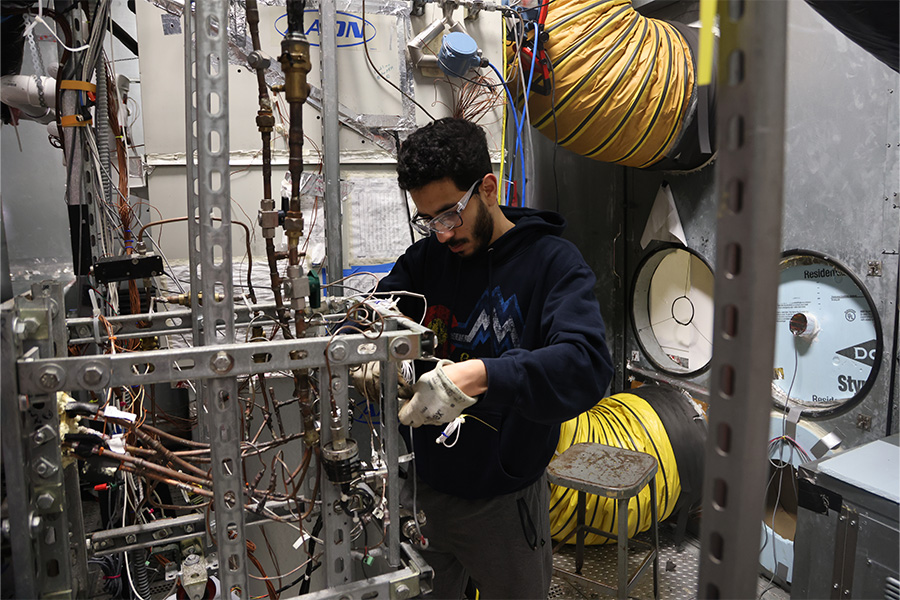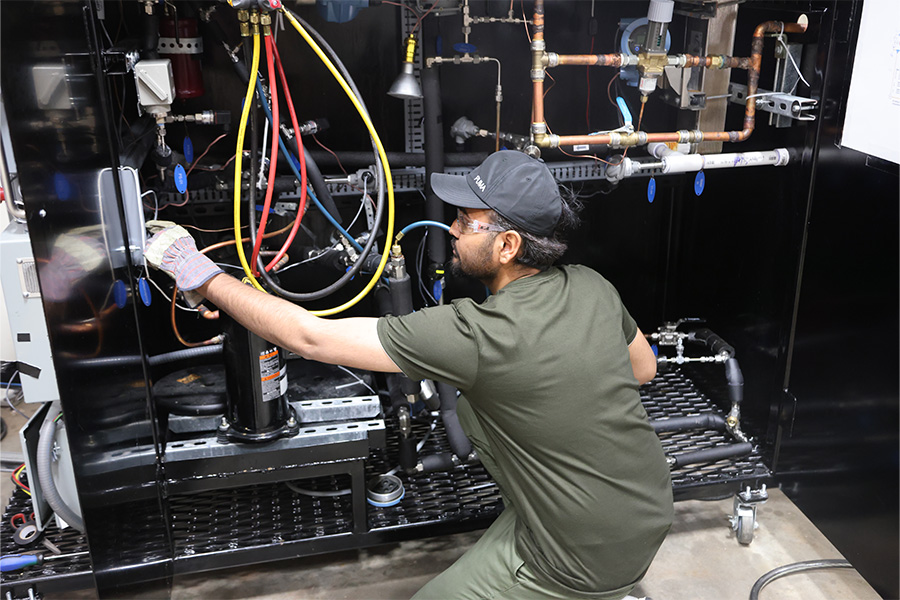
CIBS research project focuses on refrigerant innovations
Tuesday, April 8, 2025
Media Contact: Tanner Holubar | Communications Specialist | 405-744-2065 | tanner.holubar@okstate.edu
The College of Engineering, Architecture and Technology at Oklahoma State University’s Center for Integrated Building Systems brings HVAC industry professionals together with CEAT students and faculty.
CIBS meetings are held twice a year between CEAT students and faculty with industry professionals to discuss any issues the industry faces. Faculty then make research proposals that will help solve these issues.
This fosters a strong partnership between academia and the HVAC industry, leading to solutions while providing students with a great research experience.
Dr. Christian Bach, associate professor in the School of Mechanical and Aerospace Engineering, is the principal investigator on two projects funded through CIBS by various industry partners, studying refrigerants with low global warming potential. Dr. Ardeshir Moftakhari, assistant professor of MAE, is the co-principal investigator on the projects.
Both projects are two years in length and study aspects such as refrigerant glide, generating in-system test data and generating models to study how low-GWP refrigerants perform and what type of injection flow rates are required.
Heat exchangers and high-glide, low-GWP fluids
Heat exchangers transfer heat between indoor and outdoor airflows, keeping them separate to cool or heat indoor air. Many types of heat exchangers use various fluids, such as water and refrigerant-oil mixtures.
This project will investigate if heat exchangers require any changes to function with newer fluids. Older fluids have a higher global warming potential, and the longer the system runs, the higher the risk of leaks.

“It’s a combined performance of working on the systems and trying to avoid leaks in the systems,” Bach said. “It’s just going to naturally have less harmful potential. It is difficult to quantify leakage since leaks can be caused in several different ways.”
Bach said the most promising fluids being studied have what is called temperature glide - a temperature difference of the refrigerant before and after it goes through phase changes, such as a liquid to a gas.
"The temperature of phase change is not constant as the refrigerant changes from liquid to vapor or vice-versa,” Bach explained. “In addition, pressure levels are different in different systems. Both are a challenge since glide changes what is optimum design and likewise for the pressure levels.”
Bach’s team will also be tasked with studying how these fluids would impact the quality maldistribution of an HVAC system. This is when there is a low vapor-to-liquid ratio in a system that results in uneven heat transfer and reduces efficiency.
There are also challenges due to some traditional, natural refrigerants having a low environmental impact but are toxic to humans, highly flammable or require major changes to the system to be used.
“Primarily we are interested in determining how heat exchanger design needs to be changed to maintain or improve system level performance metrics – typically cooling capacity or efficiency,” Bach said.
Students involved with this project are Mohammadreza Azaddel, Amr Ashraf and undergraduate CIBS intern Carson McKinney.
Creating models for performance, flowrates for low-GWP fluids
Another project currently underway will involve creating statistical models influenced by physics to predict how compressors operate with low-GWP fluids. The team will look to develop a tunable, physics-based model for injected compressors, including injection flow rate and performance metrics.

The desired outcome will result in measured performance data for several compressors for a range of conditions, as well as creating a prototype model.
Compressors will be tested initially in a dedicated load stand, and later in a psychrometric chamber, which is designed to simulate indoor conditions for testing HVAC equipment. The team’s primary goal is to be able to predict the injection and flow rates for fluids, the discharge temperature and how much power the compressor consumes.
“That requires appropriate instrumentation, an appropriate test plan and the development of candidate models that are informed by physics to ensure robustness,” Bach said.
Students involved with this project are M. Hasanat Khan, Rasheed Shittu and undergraduate CIBS intern Sophie Hakins. Bach said the students are the “core of what will make this project successful.”
This research could result in less electricity used to heat a building due to the heat pump being able to reach lower temperatures.
“Injected compression extends the temperature range of heat pumps to lower temperatures, reducing the need for auxiliary electric heat and boosting low-temperature heating capacity compared to ‘standard’ compression,” Bach explained. “It allows us to extend heat pump application range to lower temperature climates – meaning we need less electrical generation capacity than if we’d heat with electricity directly. That electricity ultimately can come from renewable sources with fossil fuels as a backup.”
CIBS provides strong benefits to all involved
CIBS was created in 2020 to help bridge the gap between the way thermal systems components and equipment were designed and the way buildings were designed. It consists of members who are employees of a company that helps fund CIBS; faculty and students who are selected by members to work on projects; and mentors, employees of a funding company who work in advisory roles on the projects.
Since its founding, CIBS has grown into an organization with 11 member businesses that fund the research, with OSU faculty and students executing the research.
The research undertaken is based on what is needed in the industry at any given time. This is decided through detailed meetings with members and industry partners and the most feasible proposal areas are defined through those conversations.
When a proposal is selected, industry mentors are assigned to the team to meet regularly with the researchers. Bach said it is a great opportunity for students, as it can serve as a prolonged job interview where a student has a chance to eventually be hired by that company, ready to hit the ground running.
“As a professional society involved with the university, we can try to solve something that impacts all of us; with the environmental impact of the built environment that is ‘all’ in a global sense,” Bach said. “CIBS comes in and makes sure that everybody involved in the center is benefiting locally and nationally from the research. We have input, can select candidate topics, and discuss what priorities are and how we can all benefit from the collaboration.”
